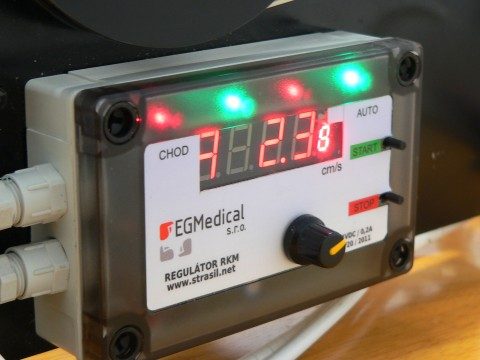Our designs from Practical Electronics
Articles from Practical Electronics from 2002 - 2015 with our designs for radio amateurs
Published constructions
From time to time we publish in the magazine Practical Electronics constructions that we have created for our own use and we are happy to share them.
It is not possible to order circuit boards or programmed processors for the constructions and for time reasons we provide only minimal support (only by e-mail, please expect a longer response time). On request, we will send firmware source codes or PCB data, or add them to the web.
For further information and support on designs published in Practical Electronics, please contact strasil@egmenergo.cz
Custom design modifications – custom development
If you are interested in custom modification or professional development of similar type of equipment, we will be glad to receive your inquiry.

Construction data for download
Power driver for 24 V motors
Power driver for 24 V motors (PE 8/2015)
The described driver is used for bidirectional control of 24 V DC brush motors by PWM control. The device is capable of delivering a continuous output current of up to 35 A without active cooling (25 A in a sealed enclosure).
The driver is equipped with a pair of parallel connected outputs, which can be individually disconnected by relays, for use in drives where two motors work together – typically in one axle of an electric trolley.
The device is controlled by simple commands over the RS-485 data bus. Up to 16 drivers can be connected to one bus simultaneously.
Build a computer with Linux from components
About thirty years ago, the predecessor of the magazine you are now holding in your hands also published instructions for building home computers from integrated circuits and discrete components.
Over the years, microcontrollers with significantly limited power, combining the entire microprocessor and memory subsystems of a computer into a single housing, have established themselves as basic elements in common industrial and amateur electronics. In contrast, PC-type computers have grown into complex systems consisting of dozens of highly integrated chips.
Only the advent of “smart” mobile devices has brought a more significant development of the category of minicomputers, i.e. devices of a lower power category that are able to run a full-fledged operating system (typically Linux or Android) with a graphical user interface and operate as a small home server or a powerful industrial control or visualization unit.
In this article, we describe the design of a simple minicomputer that is similar in performance to the well-known Raspberry Pi. The EGA13 minicomputer is based on the Allwinner A13 microprocessor, used in cheaper tablets, and is based on the Olinuxino A13 open hardware minicomputer.
The EGA13 is designed as an embedded module for insertion into a motherboard. The minicomputer comes with a Linux OS installation (image) with the possibility of running applications in the Qt graphical interface.
EZS control panel with LAN interface
EZS control panel with LAN interface (PE 4/2011)
Communication via networks based on modern Ethernet standards has recently boomed in the field of home automation after the almost complete penetration of LAN computer networks and the development of VoIP telecommunications. It seems that the time is indeed gradually approaching when almost every technical device in the house will be able to communicate via a computer network, allowing comfortable control and remote management.
This paper contributes to the issue by describing an experimental alarm control panel (electrical security alarm system – EZS), capable of communication via IP network via Ethernet interface. The control panel is capable of practical deployment, however, the author sees the main contribution of the article in the description of a relatively simple, affordable and yet powerful network interface solution without the need for special communication modules.
ECG Holter
The described device is used for measurement and long-term recording of human or animal ECG and breathing curves. These sensors are complemented by a three-axis accelerometer, which is used to detect the position and intensity of the subject’s movements.
The data can either be transferred online via Bluetooth wireless interface or the measured data can be written to the internal memory card of the instrument and then read out via USB interface.
As such, the facility is mainly used in the field of research and is suitable for familiarisation and experiments with biosignals and their processing. In particular, the breathing waveform recording is a unique feature in this category of devices.
Based on the measured data, it is possible, for example, to evaluate sleep quality or training load and recovery of athletes according to heart rate variability (HRV).
Audio NF preamplifier TLE3 with DSP
Preamplifier TLE3 with DSP (PE 6/2007)
The article describes the design of an equalizer, dynamics compressor and input switcher/mixer for home Hi-Fi or semi-professional use. The high quality and flexibility of the device is achieved by using fully digital audio processing. The device has a built-in digital USB audio interface as one of its inputs.
Digital wattmeter
This paper describes the design of a digital, microprocessor-controlled network wattmeter, power factor and energy meter with the possibility of interfacing with a PC. The device is housed in a small box with a mains plug and socket, which makes it easy to operate and use even by the layman.
Incremental counter
Incremental counter (PE 10/2007) further documentation
The paper deals with the design of a bidirectional counter for the evaluation of position measurement by an IRC (incremental) sensor. By using the IRC sensor in conjunction with the described device, it is possible to extend various machines (lathes, milling machines, but also optical devices, for example) with digital tool position measurement.
Stepper motor speed controller
Stepper motor speed controller (PE 10/2012) additional documents
A stepper motor speed controller is a device used to control the rotational speed of a stepper motor drive based on feedback from an incremental rotational encoder. The necessary control loop is implemented in software by the microcontroller.
Clock for car
The article describes the design of a simple clock with a thermometer, primarily intended for installation in a car. The clock is equipped with an 18-digit LED display that simultaneously shows the time, date, day of the week and temperature.
LC meter (PE 3/2006)
LC meter (PE 3/2006) other documents
The paper describes the design of a simple inductance, capacitance, pulse generator and nf generator up to 10 kHz, using a software implemented DDS.
Vibration signalling
Vibration signalling (PE 10/2013)
The paper describes a simple wireless linker that, on the command of a button on a handheld controller, triggers a vibrating motor in a wrist-worn receiver. The controller is equipped with five buttons and can control up to five receivers independently.
Currently, the link is used to discreetly alert security services to a suspicious person.
MPE4 precision electricity meter (PE 7/2010)
Precision electricity meter MPE4 (PE 7/2010) other documents
The paper describes a precision electric meter of accuracy class 0.2 for industrial use, equipped with a pulse output with the possibility of extension with a communication module for common industrial buses. The meter in this version operates with a nominal mains voltage of 230 V and with power inputs up to 920 W (4 A).
Secondary backup source
Secondary backup power supply (PE 12/2010)
In practice, there are often situations where it is necessary to back up the power supply of electrical equipment with a battery. However, we do not always have a power grid available to use a commonly available backup power supply for ESS systems – we encounter installations where it is necessary to back up an existing DC power supply, for example, to power a car alarm system or to ensure partial functionality of large-scale home alarm systems, EPS or automation even in the event of a failure or interruption of some lines.
The described back-up power supply supplies the connected equipment with a current consumption of up to 4 A at 12 V from a maintenance-free lead-acid battery, which can be recharged with a DC input voltage in the range of 7 to 24 V.
Precision electronic ballast
Precision Electronic Ballast (PE 5/2008)
The electronic load cell is one of the basic instruments for measuring and controlling power supplies. The paper describes the design of an electronic load with digital parameter setting, the possibility of external current modulation and operation in constant current, resistance or voltage mode. The range of applications is extended by USB communication with a PC, the ability to control multiple loads together and the function for measuring the energy drawn and the internal resistance of the tested power supply.
Universal voice module
Universal voice module (PE 10/2005)
Nowadays very outdated design of voice memory using ATMega microcontroller and FLASH memory. Implements voice output for METEX multimeters.
Outage monitoring of 64 circuit breakers via SMS messages
Outage monitoring of 64 circuit breakers by SMS messages (PE ??/2011) additional documents
The described design was created for monitoring the failures of a total of 64 circuit breakers of a certain large technological unit, in general for the transmission of 64 binary signals. The whole system consists of a control unit with a GSM module, which ensures sending SMS messages about changes in the status of the monitored unit, and data acquisition modules, which are individually installed to the sources of the monitored signal. The data acquisition modules are connected to the control unit by a multiplexed current loop in such a way that a single eight-core CAT 5 cable is sufficient to transmit 32 signals over a distance of up to 500 metres, while maintaining the very low cost of ownership.
Power servo amplifier
Power servo amplifier (PE 5/2012) firmware PCB documentation
The device is a servo amplifier for a 12 to 24 V / 5 A DC motor, controlled by a standard model servo signal and controlled by a microcontroller. The feedback is implemented by a potentiometer.
Scenic LED lighting control
Scenic control of LED lighting (PE 8/2013)
Quadruple dimmer for 12 V LED strips, wirelessly controlled, together with touch transmitter. The device is equipped with light scene memory and allows you to teach multiple drivers to multiple receivers and create relatively complex lighting installations with very simple elements.
Equalizer digitally
Rather a demonstration design allowing to explore digital audio signal processing using DSP, controlled from a computer.
Hearing Amplifier and Transmitter for Induction Loop (“T”)
Hearing Amplifier (PE ??/cca 2004)
The paper describes the design of a personal hearing amplifier for the hearing impaired with the possibility of receiving sound by means of an inductive loop, intended mainly to improve the intelligibility of television and radio broadcasts in cases where the use of an in-ear hearing aid is not sufficient. The subject of the paper is also a description of the corresponding transmitter for the inductive loop.
Double optocoupler
Double optocoupler (PE 6/2005)
Simple microprocessor-controlled double optocoupler, also suitable for basic industrial use.
Security
The author assumes that only persons who are sufficiently instructed in the principles of electrical circuits and safety when working with electrical equipment will build the published structures. Especially those structures that use mains power should only be built by people with the appropriate training and qualifications!
Copyright
The constructions disclosed herein are intended as a basis for individual construction of the apparatus. Commercial use is subject to the express written consent of the author, as is further publication of the constructions published here.


